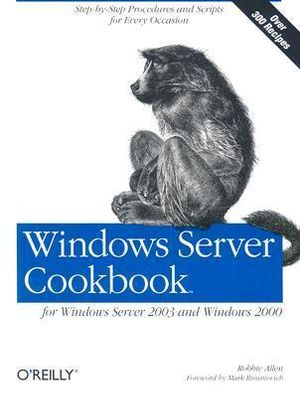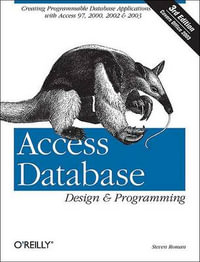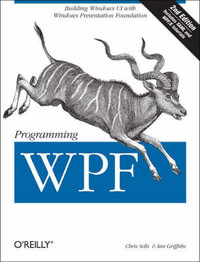
Instant online reading.
Don't wait for delivery!
At a Glance
670 Pages
23.93 x 17.88 x 3.18
Paperback
RRP $85.50
$43.75
49%OFF
or 4 interest-free payments of $10.94 with
orAims to ship in 15 to 25 business days
When will this arrive by?
Enter delivery postcode to estimate
This practical reference guide offers hundreds of useful tasks for managing Windows 2000 and Windows Server 2003, Microsoft's latest and greatest server. Through concise, on-the-job solutions to common problems, Windows Server Cookbook for Windows Server 2003 & Windows 2000 is certain to save you hours of time searching for answers.Now, instead of dredging reams of Microsoft documentation or browsing its unstructured knowledge base to figure out a particular issue--such as how to compare registry values between two hosts--you can simply reference the index of Windows Server Cookbook for Windows Server 2003 & Windows 2000. From there, you'll be directed to the exact trouble-shooting recipe they need.As the newest title in O'Reilly's popular Cookbook series, this book covers a wide range of issues that you are likely to face in your daily management of the Windows Server operating system. This includes how to deal with:
- files
- event logs
- DNS
- DHCP
- security
- the registry
- backup/restore
| Foreword | p. xvii |
| Preface | p. xix |
| Introduction | p. 1 |
| Approach to the Book | p. 2 |
| Where to Find the Tools | p. 3 |
| Running Tools with Alternate Credentials | p. 5 |
| A Brief Word on Windows Scripting | p. 6 |
| Getting the Most Out of Your Scripts | p. 6 |
| Where to Find More Information | p. 15 |
| System Configuration | p. 19 |
| Activating Windows Server 2003 | p. 20 |
| Configuring Automatic Updates | p. 23 |
| Disabling Windows Update | p. 26 |
| Installing or Uninstalling a Windows Component | p. 27 |
| Installing an Application or Service Pack via Group Policy | p. 30 |
| Viewing System Properties | p. 32 |
| Setting the System Time, Date, and Time Zone | p. 34 |
| Setting the Name of a Server | p. 37 |
| Joining a Server to a Domain | p. 40 |
| Testing and Resetting the Secure Channel | p. 43 |
| Viewing and Setting Environment Variables | p. 45 |
| Configuring Page Files | p. 48 |
| Putting System Information on the Desktop | p. 51 |
| Configuring System Startup Options | p. 52 |
| Configuring System Failure Options | p. 55 |
| Viewing System Uptime | p. 59 |
| Disabling the Manage/Configure Your Server Screen | p. 60 |
| Disabling Shutdown Tracker | p. 62 |
| Restarting or Shutting Down a Server | p. 64 |
| Disks, Drives, and Volumes | p. 68 |
| Viewing the Disk, Drive, and Volume Layout | p. 70 |
| Converting a Basic Disk to Dynamic | p. 72 |
| Enabling Disk Performance Statistics | p. 73 |
| Formatting a Volume | p. 74 |
| Setting the Drive Letter of a Volume | p. 76 |
| Setting the Label of a Volume | p. 78 |
| Cleaning Up a Volume | p. 79 |
| Defragmenting a Volume | p. 80 |
| Compressing a Volume | p. 84 |
| Checking a Volume for Errors | p. 86 |
| Making a Disk or Volume Read-Only | p. 88 |
| Mapping a Network Drive | p. 89 |
| Creating a Virtual Drive to Another Drive or Folder | p. 91 |
| Finding Large Files and Folders on a Volume | p. 93 |
| Enabling Disk Quotas | p. 94 |
| Configuring a Disk Quota for a User | p. 96 |
| Viewing Disk Quota Usage | p. 98 |
| Files, Folders, and Shares | p. 100 |
| Creating and Deleting a File | p. 102 |
| Creating and Deleting a Folder | p. 103 |
| Undeleting a File | p. 104 |
| Securely Deleting a File | p. 105 |
| Viewing the Properties of a File or Folder | p. 106 |
| Creating a Shortcut | p. 108 |
| Creating a Link or Junction Point | p. 112 |
| Creating a Program Alias | p. 113 |
| Searching for Files or Folders | p. 114 |
| Copying, Moving, or Renaming a File or Folder | p. 116 |
| Comparing Files or Folders | p. 117 |
| Hiding a File or Folder | p. 118 |
| Making a File or Folder Read-Only | p. 120 |
| Compressing a File or Folder | p. 121 |
| Encrypting a File or Folder | p. 124 |
| Replacing a File That Is in Use | p. 125 |
| Taking Ownership of a File or Folder | p. 126 |
| Finding Who Last Opened or Modified a File | p. 128 |
| Finding Open Files | p. 129 |
| Finding the Process That Has a File Open | p. 130 |
| Viewing File Activity | p. 132 |
| Performing an Action on Several Files at Once | p. 133 |
| Creating and Deleting Shares | p. 134 |
| Viewing Shares | p. 136 |
| Restricting Access to a Share | p. 137 |
| Enabling Web Sharing | p. 138 |
| Publishing a Share in Active Directory | p. 140 |
| Running and Scheduling Tasks | p. 142 |
| Running a Task with Alternate Credentials | p. 142 |
| Running a Task on a Remote Server | p. 145 |
| Running a Task When a User Logs On | p. 147 |
| Running a Task via a Login Script | p. 149 |
| Running a Task via Group Policy | p. 151 |
| Listing Automatic Tasks | p. 152 |
| Scheduling a Task | p. 153 |
| Deleting a Scheduled Task | p. 156 |
| Listing the Scheduled Tasks | p. 158 |
| Processes | p. 160 |
| Setting the Priority of a Process | p. 164 |
| Suspending a Process | p. 166 |
| Killing a Process | p. 167 |
| Viewing the Running Processes | p. 169 |
| Searching Processes | p. 170 |
| Finding the Services Run from a Process | p. 171 |
| Viewing the Properties of a Process | p. 173 |
| Viewing the Performance Statistics of a Process | p. 174 |
| Viewing the DLLs Being Used by a Process | p. 175 |
| Viewing the APIs Called by a Process | p. 177 |
| Viewing the Handles a Process Has Open | p. 178 |
| Viewing the Network Ports a Process Has Open | p. 179 |
| Script: Process Doctor | p. 180 |
| Script: Process Terminator | p. 183 |
| Services | p. 185 |
| Starting and Stopping a Service | p. 188 |
| Running Any Program or Script as a Service | p. 190 |
| Removing a Service | p. 193 |
| Setting the Service Startup Type | p. 195 |
| Setting the Service Account and Password | p. 196 |
| Performing an Action Automatically When a Service Fails | p. 198 |
| Viewing the List of Services | p. 199 |
| Searching Services | p. 201 |
| Finding the Process a Service Is Running From | p. 202 |
| Viewing the Antecedent and Dependent Services for a Service | p. 203 |
| Viewing the Service Load Order | p. 205 |
| Viewing the Startup History of a Service | p. 207 |
| Granting the Permission to Manage One or More Services | p. 209 |
| Script: Robust Service Restart | p. 210 |
| Script: Service Monitor | p. 212 |
| Event Logs | p. 214 |
| Creating an Event | p. 215 |
| Viewing Events | p. 217 |
| Creating a New Event Log | p. 219 |
| Viewing the Size of an Event Log | p. 221 |
| Setting the Maximum Size of an Event Log | p. 222 |
| Setting the Event Log Retention Policy | p. 223 |
| Clearing the Events in an Event Log | p. 225 |
| Restricting Access to an Event Log | p. 226 |
| Searching an Event Log on a Server | p. 227 |
| Searching the Event Logs on Multiple Servers | p. 229 |
| Archiving an Event Log | p. 231 |
| Finding More Information About an Event | p. 232 |
| Triggering an Action When an Event Occurs | p. 233 |
| Script: Event Watcher | p. 234 |
| Registry | p. 237 |
| Creating and Deleting a Key | p. 239 |
| Setting a Value | p. 241 |
| Setting Keys or Values Using Group Policy | p. 243 |
| Exporting Registry Files | p. 244 |
| Importing Registry Files | p. 246 |
| Searching the Registry | p. 247 |
| Comparing the Registry | p. 248 |
| Restricting Access to the Registry | p. 249 |
| Backing Up and Restoring the Registry | p. 251 |
| Creating a Registry Link | p. 253 |
| Setting the Maximum Registry Size | p. 254 |
| Monitoring Registry Activity | p. 256 |
| Viewing Processes That Have a Registry Key Open | p. 258 |
| Network Configuration | p. 260 |
| Viewing the Network Configuration | p. 261 |
| Disabling a Connection | p. 264 |
| Configuring an IP Address | p. 266 |
| Renewing or Releasing a DHCP IP Address | p. 269 |
| Configuring DNS Settings | p. 271 |
| Registering DNS Records or Flushing the DNS Cache | p. 273 |
| Finding a Computer's Active Directory Site | p. 275 |
| Managing Routes | p. 276 |
| Viewing the Open Ports and Connections | p. 279 |
| Troubleshooting Network Connectivity Problems | p. 281 |
| Viewing Network Traffic | p. 282 |
| Configuring TCP/IP Filtering | p. 284 |
| Measuring Link Speed and Latency Between Two Hosts | p. 287 |
| Installing the IPv6 Stack | p. 288 |
| Security Best Practices | p. 290 |
| Analyzing Your Security Configuration | p. 293 |
| Enabling Auditing | p. 294 |
| Renaming the Administrator and Guest Accounts | p. 297 |
| Disabling or Removing Unused Accounts, Services, and Software | p. 300 |
| Enabling Screensaver Locking | p. 300 |
| Disabling Storage of the LM Password Hash | p. 303 |
| Requiring Strong Passwords | p. 304 |
| Getting Notified of New Security Vulnerabilities | p. 305 |
| Script: Mass Admin Password Changer | p. 305 |
| Internet Information Services 6.0 | p. 308 |
| Installing IIS | p. 313 |
| Stopping and Starting IIS | p. 318 |
| Creating Web Sites | p. 320 |
| Hosting Multiple Web Sites | p. 322 |
| Creating Virtual Directories | p. 325 |
| Configuring Web Permissions | p. 327 |
| Configuring IP Address and Domain Name Restrictions | p. 330 |
| Configuring Web Site Authentication | p. 332 |
| Obtaining and Installing SSL Certificates | p. 335 |
| Enabling SSL on a Web Site | p. 337 |
| Backing Up SSL Certificates | p. 340 |
| Configuring Web Site QoS Settings | p. 341 |
| Configuring Web Site Logging | p. 343 |
| Configuring Web Site Redirection | p. 346 |
| Enabling Direct Metabase Editing | p. 348 |
| Backing Up and Restoring the Metabase | p. 350 |
| Exporting and Importing the Metabase | p. 354 |
| Enabling Dynamic Content | p. 356 |
| Creating Application Pools | p. 358 |
| Configuring Application Pool Identities | p. 359 |
| Creating Applications | p. 361 |
| Isolating Applications into Pools | p. 363 |
| Configuring Application Pool Recycling | p. 364 |
| Creating FTP Sites | p. 366 |
| Configuring FTP Authentication | p. 369 |
| Configuring FTP User Isolation | p. 370 |
| Domain Name System (DNS) | p. 373 |
| Installing the DNS Server | p. 375 |
| Starting and Stopping the DNS Server | p. 377 |
| Modifying DNS Server Configuration | p. 379 |
| Creating a Zone | p. 381 |
| Viewing a DNS Server's Zones | p. 383 |
| Converting a Zone to an Active Directory-Integrated Zone | p. 385 |
| Moving Active Directory-Integrated Zones into an Application Partition | p. 387 |
| Creating a Stub Zone | p. 389 |
| Configuring Conditional Forwarding | p. 392 |
| Configuring Zone Transfer | p. 394 |
| Creating and Deleting Resource Records | p. 397 |
| Querying Resource Records | p. 400 |
| Scavenging Old Resource Records | p. 401 |
| Clearing the DNS Cache | p. 404 |
| Enabling DNS Server Debug Logging | p. 405 |
| Viewing DNS Server Utilization Statistics | p. 408 |
| Preventing Cache Pollution on DNS Servers | p. 410 |
| Preventing Windows Clients from Attempting Dynamic Updates | p. 411 |
| Script: DNS Server Configuration Checker | p. 413 |
| DHCP Server | p. 416 |
| Installing DHCP Server | p. 419 |
| Authorizing a DHCP Server | p. 420 |
| Configuring Server Options | p. 423 |
| Enabling Address Conflict Detection | p. 424 |
| Creating a Scope | p. 426 |
| Creating a Superscope | p. 428 |
| Activating or Deactivating a Scope | p. 429 |
| Configuring Scope Options | p. 430 |
| Enabling Dynamic DNS Updates from the DHCP Server | p. 432 |
| Managing the Leases for a Scope | p. 434 |
| Creating a Reservation | p. 435 |
| Enabling DHCP Audit Logging | p. 436 |
| Modifying the DHCP Database and Audit Log Paths | p. 439 |
| Backing Up the DHCP Database | p. 440 |
| Restoring the DHCP Database | p. 441 |
| Importing and Exporting DHCP Server Configuration | p. 442 |
| Viewing DHCP Utilization Statistics | p. 444 |
| Finding the DHCP Servers on a Subnet | p. 445 |
| Running DHCP Server on a Domain Controller | p. 447 |
| Active Directory | p. 449 |
| Creating a New Active Directory Forest | p. 450 |
| Promoting a Domain Controller from Media | p. 452 |
| Uninstalling Active Directory | p. 453 |
| Upgrading from Windows 2000 to Windows Server 2003 | p. 455 |
| Raising the Functional Level | p. 459 |
| Backing Up Active Directory | p. 462 |
| Restoring Active Directory | p. 464 |
| Searching for Objects in a Domain | p. 467 |
| Creating an Object | p. 471 |
| Modifying an Object | p. 473 |
| Moving an Object | p. 475 |
| Moving an Object to a Different Domain | p. 477 |
| Renaming an Object | p. 478 |
| Deleting an Object | p. 480 |
| Exporting and Importing Objects Using LDIF or CSV | p. 482 |
| Finding the Closest Domain Controller | p. 484 |
| Enabling and Disabling the Global Catalog | p. 486 |
| Finding the FSMO Role Holders | p. 488 |
| Transferring or Seizing a FSMO Role | p. 490 |
| Creating and Removing a Trust | p. 492 |
| Viewing the Trusts for a Domain | p. 494 |
| Verifying and Resetting Trusts | p. 497 |
| Enabling Diagnostics Logging | p. 500 |
| Script: Displaying the Structure of a Forest | p. 502 |
| Domain User, Group, and Computer Accounts | p. 505 |
| Creating a User Account | p. 506 |
| Creating a Large Number of Users | p. 508 |
| Modifying an Attribute for Several Users at Once | p. 509 |
| Unlocking a User | p. 511 |
| Troubleshooting Account Lockout Problems | p. 512 |
| Viewing and Modifying the Account Lockout and Password Policies | p. 513 |
| Enabling and Disabling a User Account | p. 517 |
| Setting a User's Password | p. 518 |
| Setting a User's Account Options | p. 519 |
| Setting a User's Profile Attributes | p. 522 |
| Finding a User's Last Logon Time | p. 523 |
| Creating a Group Account | p. 525 |
| Viewing the Members of a Group | p. 526 |
| Viewing a User's Group Membership | p. 528 |
| Adding and Removing Members of a Group | p. 530 |
| Changing the Scope or Type of a Group | p. 531 |
| Creating a Computer Account | p. 533 |
| Joining a Computer to a Domain | p. 534 |
| Renaming a Computer | p. 537 |
| Resetting a Computer Account | p. 539 |
| Exchange Server 2003 | p. 542 |
| Preparing Active Directory for Exchange | p. 545 |
| Installing the First Exchange Server | p. 549 |
| Installing Additional Exchange Servers | p. 551 |
| Installing an Exchange Service Pack | p. 553 |
| Creating Unattended Installation Files for Exchange and Exchange Service Pack | p. 554 |
| Installing Exchange Management Tools | p. 555 |
| Delegating Exchange for the First Time | p. 557 |
| Stopping and Starting Exchange Server | p. 560 |
| Mail-Enabling a User | p. 562 |
| Mail-Disabling a User | p. 567 |
| Mailbox-Enabling a User | p. 569 |
| Deleting a User's Mailbox | p. 572 |
| Purging a Deleted Mailbox | p. 574 |
| Reconnecting a Deleted Mailbox | p. 575 |
| Enumerating Disconnected Mailboxes | p. 577 |
| Moving a Mailbox | p. 579 |
| Viewing Mailbox Sizes and Message Counts | p. 582 |
| Mail-Enabling a Contact | p. 583 |
| Mail-Disabling a Contact | p. 586 |
| Creating a Mail-Enabled Distribution List | p. 587 |
| Creating a Query-Based Distribution List | p. 591 |
| Creating an Address List | p. 594 |
| Creating a Recipient Policy | p. 597 |
| Creating a Storage Group | p. 599 |
| Creating a Mailbox Store | p. 602 |
| Listing Domain Controllers and Global Catalog Servers Used by an Exchange Server | p. 604 |
| Mounting and Dismounting Mailbox Stores | p. 605 |
| Introduction to WSH | p. 609 |
| Introduction to WMI | p. 613 |
| Introduction to ADSI | p. 618 |
| List of Default Environment Variables | p. 625 |
| List of Default Processes | p. 629 |
| List of Default Services | p. 631 |
| Index | p. 641 |
| Table of Contents provided by Ingram. All Rights Reserved. |
ISBN: 9780596006334
ISBN-10: 0596006330
Series: O'Reilly Software Ser.
Published: 24th March 2005
Format: Paperback
Language: English
Number of Pages: 670
Audience: Professional and Scholarly
Publisher: OREILLY MEDIA
Country of Publication: US
Dimensions (cm): 23.93 x 17.88 x 3.18
Weight (kg): 0.96
Shipping
| Standard Shipping | Express Shipping | |
|---|---|---|
| Metro postcodes: | $9.99 | $14.95 |
| Regional postcodes: | $9.99 | $14.95 |
| Rural postcodes: | $9.99 | $14.95 |
How to return your order
At Booktopia, we offer hassle-free returns in accordance with our returns policy. If you wish to return an item, please get in touch with Booktopia Customer Care.
Additional postage charges may be applicable.
Defective items
If there is a problem with any of the items received for your order then the Booktopia Customer Care team is ready to assist you.
For more info please visit our Help Centre.
You Can Find This Book In

Access Database Design & Programming
Creating Programmable Database Applications with Access 97, 2000, 2002 & 2003
Paperback
RRP $76.00
$39.40
OFF
This product is categorised by
- Non-FictionComputing & I.T.Operating SystemsMicrosoft (Windows) Operating Systems
- Non-FictionComputing & I.T.Computer Networking & CommunicationsNetworking Standards & Protocols
- Non-FictionComputing & I.T.Computer HardwareMaintenance & Repairs
- Non-FictionComputing & I.T.Computer Networking & CommunicationsElectronic Mail or Email for Professionals
- Booktopia Publisher ServicesJohn Wiley & Sons Publishers UK






















